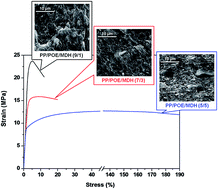Morphology development of PP/POE blends with high loading of magnesium hydroxide
Abstract
The influence of a high loading of magnesium hydroxide (Mg(OH)2, MDH) on the morphology and properties of polypropylene (PP)/ethylene–octene copolymer (POE) blends has been investigated via scanning electron microscopy, dynamic mechanical thermal analysis and tensile mechanical testing. It was demonstrated that the mechanical properties, especially the elongation at break, are highly related to the phase structure exhibited by the composites. In the PP/POE 90/10 and 70/30 blends, the addition of a high loading of MDH lowered the average diameter of the dispersed POE domains, also the MDH and POE domains were separately dispersed in the PP matrix. Meanwhile, the elongation at break of the samples sharply declined to an unacceptable level. While in the PP/POE 50/50 blends, a co-continuous structure was formed and it could be maintained even after a large amount of MDH was added. The co-continuous structure was found to be a key factor for tolerating high loading of additives and retaining acceptable mechanical properties, especially the elongation at break.


 Please wait while we load your content...
Please wait while we load your content...